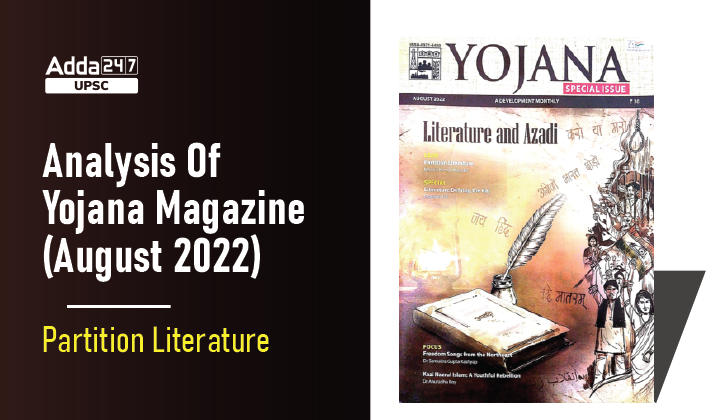Table of Contents
Yojana Magazine is a very important and indispensable source for UPSC Civil Services Exam Preparation. Here, we come with ”Analysis Of Yojana Magazine” which covers the monthly Yojana Magazine keeping in mind the demand of UPSC, particularly from the topics of important government schemes.
In ‘‘Analysis Of Yojana Magazine,” we cover each and every topic of the Yojana edition of a particular month and provide an easy-to-understand gist.
This topic-wise analysis is prepared from the August 2022 edition of the monthly Yojana Magazine.
Partition Literature: Introduction
- The repercussions of Partition of August 1947 are felt to this day. It uprooted millions and impacted life and demography in different regions from Punjab, Bengal, Sindh to Tripua and Delhi, among others.
- The Premise of partition literature is developed as a literary genre and accepted in the 1970s, however, it started with the advent of nation-state and the end of the colonial enterprise.
Partition Literature: Background
- Partition literature was started with the advent of nation-state and end of colonial rule but it developed into a distinct genre and was accepted in the 1970s.
- It refers to writings that chronicle and explore the event, from all sides of the border. It includes non-fiction as well as fictional narratives.
Partition Literature: What is Partition literature?
- Partition literature refers to writings that chronicle and explore the event, from all sides of the borders. It includes non-fiction as well as fictional narratives.
- The Partition, which in 1947 resulted in the creation of India and Pakistan (Pakistan would later be partitioned in 1971 with East Pakistan becoming Bangladesh), remains one of the most traumatic events in the subcontinent’s history.
- Millions were displaced and, according to some estimates, more than a million lost their lives.
- Today, Partition literature is studied in some universities of India either through a specific paper, or through related texts in other papers.
Partition Literature: Background
- Partition literature was started with the advent of nation-state and end of colonial rule but it developed into a distinct genre and was accepted in the 1970s.
- It refers to writings that chronicle and explore the event, from all sides of the border. It includes non-fiction as well as fictional narratives.
Partition Literature: Worldwide
- A few examples of Worldwide Partition Literature are:
- Ghasan Kanafani’s ‘Men in the Sun’-1962-Palestine/Israel
- Salman Rushdie’s ‘Midnight’s Children’-1980-India/Pakistan
- Seamus Deane’s- ‘Reading in the Dark’-1996-Ireland Partition
- Akhteruzzaman Elias (from Bangladesh)- ‘The soldier in the Attic’ and ‘The Saga of Dreams’ – 1996-Pakistan/Bangladesh
- Pak wan Suh’s -The Naked Tree-1970-Korean Partition
- Geetanjali Shree’s Hindi novel- ‘Ret Samadhi’ (‘Tomb of Sand’ in English)-2018-on India Partition(In 2022, this book became the first novel translated from an Indian language to win the International Booker Prize.)
Partition Literature: Why is Partition literature relevant?
- It is not possible for just the official accounts of Partition to contain this vast range of experiences.
- Partition literature plays its role in bringing forth the many truths that were involved, particularly from marginalised perspectives.
- Reading Partition literature helps us “rethink our positions” and offers a chance to engage more deeply with our past.
Partition Literature: Partition Literature in India
- Three partitions took place in India to form three separate states in 1905, 1947 and 1971.
- The partition literature speaks about the reality of refuge, psychological trauma along with accounts of Independence and the partition.
- Poetry, drama, short stories and novels have been written.
- A few examples of Indian Hindi, and Urdu partition literature
- Saadat Hasan Manto – ‘Thanda Gosht’, ‘Toba Tek Singh’, ‘Khol Do’, ‘Dog of Titwal’
- Krishen Chander – ‘Peshawar Express’
- Khushwant Singh – ‘Train to Pakistan’
- Yashpal – ‘Jhoota Sach’
- KS Duggal – ‘Band Darwaze’
- Examples of Bengali literature:
- Ritwik Ghatak portrayed Bengal partition with the deepest sense of insecurity of human existence.
- Amarendra Ghosh – Bhangche Sudhu Bhangche
- Jyotirmayee Debi – E-par Ganga O-par Ganga
(Above narratives are of traumatic experience, violence, rape and abduction of women.)
Partition Literature: Historiography of Indian Partition
- In the first five decades, partition literature was committed to ‘high politics’ and this gradually shifted to feministic stance, oral narratives from the survivor and caste angle.
- The non fiction narrative goes on with arguments and counter-arguments.
- Non-fiction partition literature
- Dr. B.R. Ambedkar – ‘Pakistan or Partition of India’
- Dr. Syama Prasad Mukherjee – ‘Awake Hindustan!’
- Penderal Moon – ‘’Divide and Quit’
- Maulana Abdul Kalam Azad – India Wins Freedom
- Hiranmoy Bandopadhyay – ‘Udbastu’ in Bengali
Partition Literature: Women’s voices in Partition literature
Women Before 1992
- Novels like Jyotirmoyee Devi’s Epar Ganga Opar Ganga (1968)
- Amrita Pritam’s Punjabi poem “Aaj Aakhaan Waris Shah Nu (Today I Invoke Waris Shah)
Women After 1992
- Developed after around 50 years of Independence, a new wave of feminist perspective emerged.
- Examples of Feminist Partition Literature:
- Urvashi Butalia – ‘The Other Side of Silence: Voices from the Partition of India’
- Ritu Menon and Ritu Memon – ‘Border and Boundaries’
- Jasodhara Bagchi – ‘Trauma and Triumph’
- Bapsi Sidhwa’s novel Ice Candy Man (1992)
- Sunanda Sikdar’s Partition memoir Doyamoyeer Kotha (translated into English as A Life Long Ago)
- Pakistani historian Anam Zakaria, who has written two books about partitions in the Indian subcontinent: The Footprints of Partition: Narratives of Four Generations of Pakistanis and Indians (2015) and 1971: A People’s History from Bangladesh, Pakistan and India (2019).
- Pakistani author Khadija Mastoor’s Urdu novel ‘Aangan’



 TSPSC Group 1 Question Paper 2024, Downl...
TSPSC Group 1 Question Paper 2024, Downl...
 TSPSC Group 1 Answer key 2024 Out, Downl...
TSPSC Group 1 Answer key 2024 Out, Downl...
 UPSC Prelims 2024 Question Paper, Downlo...
UPSC Prelims 2024 Question Paper, Downlo...




